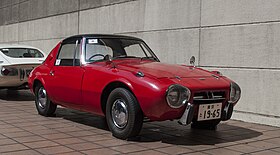Toyota Sports 800
| Toyota Sports 800 | |
|---|---|
 |
|
| Overview | |
| Manufacturer | Toyota |
| Also called | UP15, Yotahachi |
| Production | 1965–1969 |
| Designer | Tatsuo Hasegawa |
| Body and chassis | |
| Class | Sports car |
| Body style | 2-door roadster 2-door coupé |
| Layout | Front-engine, rear-wheel-drive |
| Related | Toyota Publica |
| Powertrain | |
| Engine | 790 cc 2U-B H2 |
| Dimensions | |
| Wheelbase | 2,000 mm (78.7 in) |
| Length | 3,580 mm (140.9 in) |
| Width | 1,465 mm (57.7 in) |
| Height | 1,176 mm (46.3 in) |
| Curb weight | 580 kg (1,279 lb) |
| Chronology | |
| Predecessor | None |
| Successor | None |
The Toyota Sports 800 is Toyota Motor Corporation's first production sports car. The prototype for the Sports 800, called the Toyota Publica Sports, debuted at the 1962 Tokyo Auto Show, featuring a space age sliding canopy and utilizing the 21 kW (28 hp) power train of the Toyota Publica 700, a Japanese market economy car. The Toyota Sports 800 is affectionately called the "Yota-Hachi" (ヨタハチ), which is a Japanese short form for "Toyota 8". In Japan, the vehicle was exclusive to Toyota Japan retail sales channel called Toyota Public Store alongside the Publica.
In 1965, the car went into actual production, with chassis code UP15 and an increase in engine displacement from 700 cc to 800 cc, as well as dual carburetors, which increased power from 28 to 45 PS (21 to 33 kW). This engine was sufficient to power the light car around town at 70 km/h (45 mph) or on a race track up to about 160 km/h (100 mph). Production started after the introduction of Honda's first car, called the Honda S500, and joined the market segment that was already represented by the Datsun Fairlady, and the Daihatsu Compagno.
The car had aerodynamic styling by Shozo Sato, a designer on loan from Datsun, and Toyota engineer Tatsuo Hasegawa. Hasegawa had been an aircraft designer in World War II and the resulting Sports 800 was a lightweight and agile machine. The Sports 800 was one of the first production cars featuring a lift-out roof panel, or targa top, pre-dating the Porsche Targa. The aluminum targa top could be stored in the trunk, when not in use.
Between 1965 and 1969 approximately 3,131 units were built by Toyota subcontractor Kanto Auto Works. Only about 10% of those vehicles are known to have survived, most being in Japan.
Production Tables show 1,235 cars manufactured in 1965, 703 in 1966, 538 in 1967, 440 in 1968, and 215 in 1969.
The vast majority of the 3,131 cars were right hand drive, but some 300 were left hand drive models, built primarily for the Okinawa market. (Okinawa, having been American occupied, drove on the "other side" from the rest of Japan.) A very limited number of left hand drive cars were used by Toyota to "test drive" in the US, but Toyota made a decision not to import or sell the cars in the US market.
...
Wikipedia
